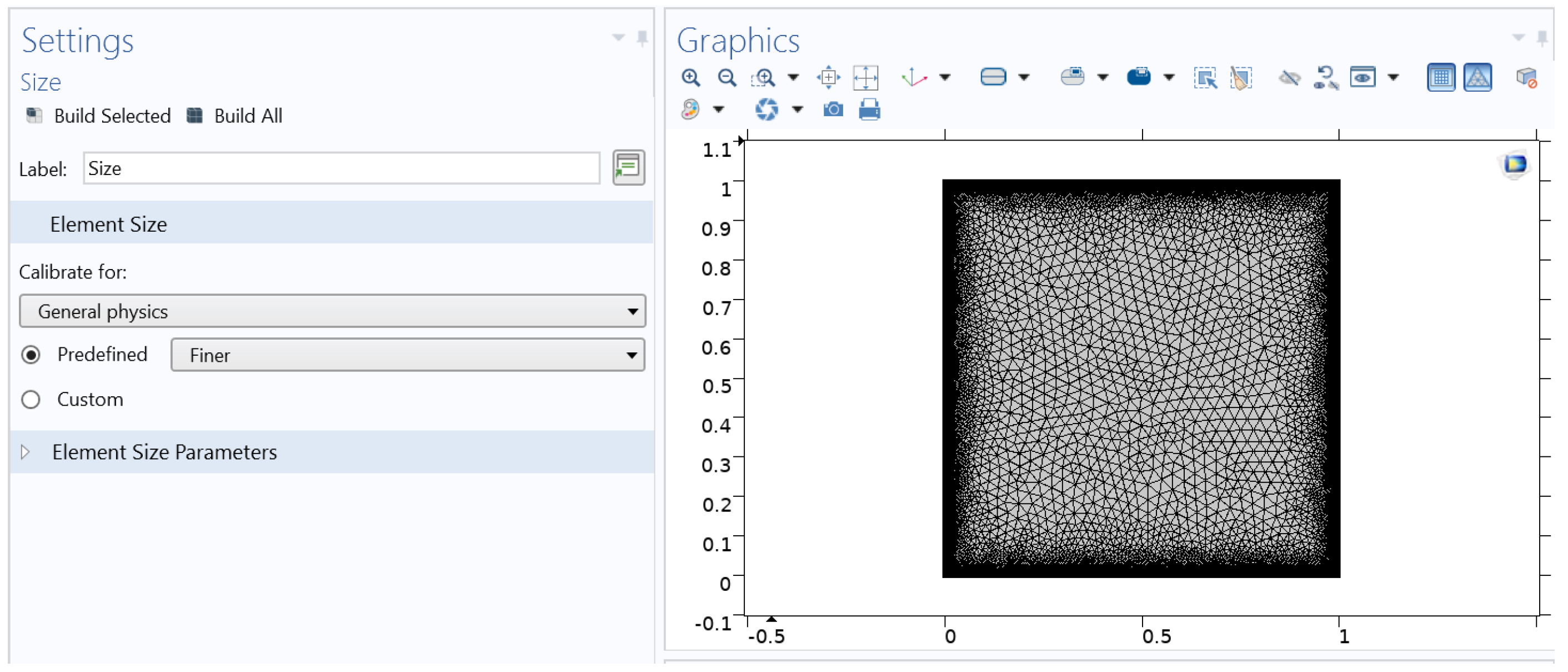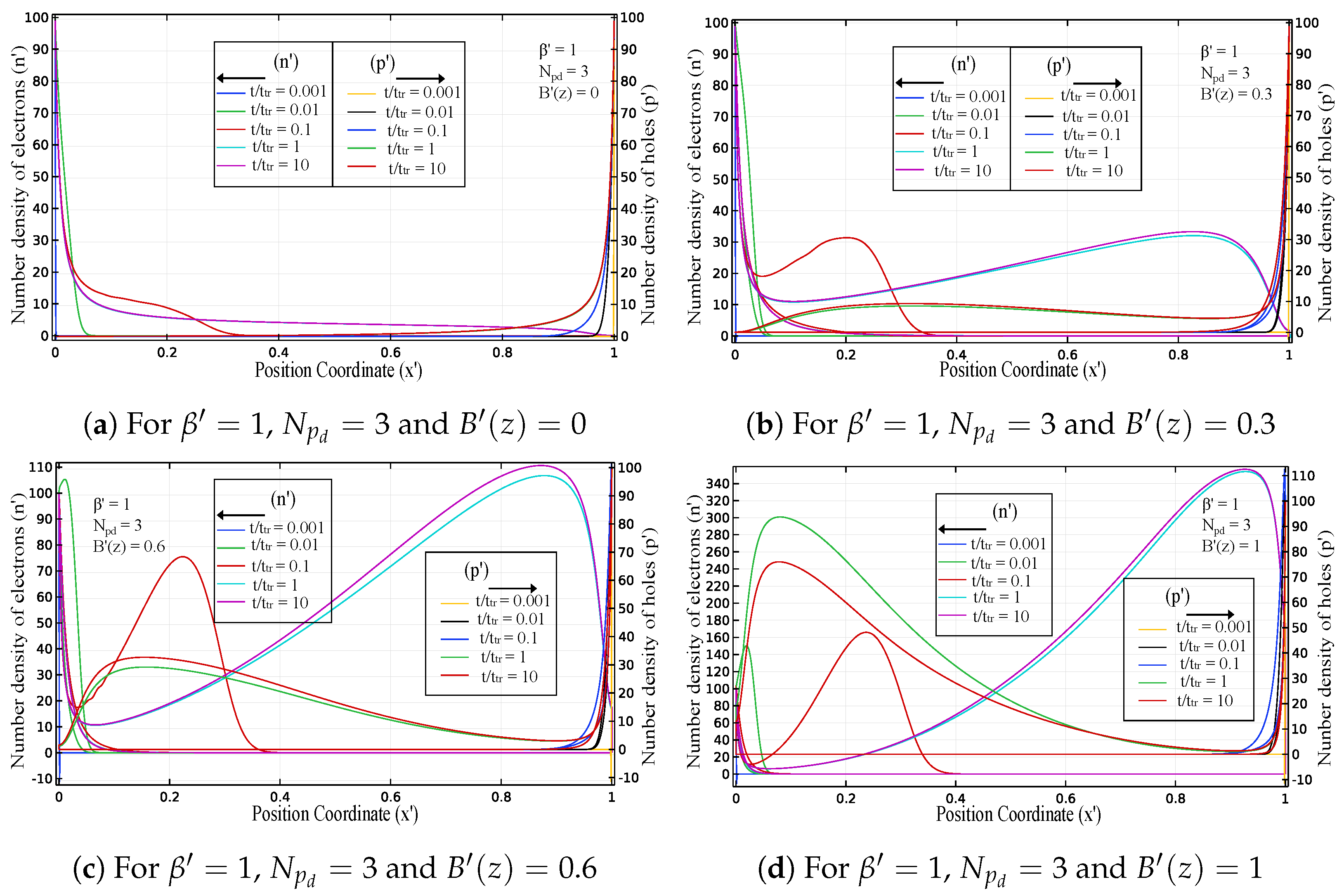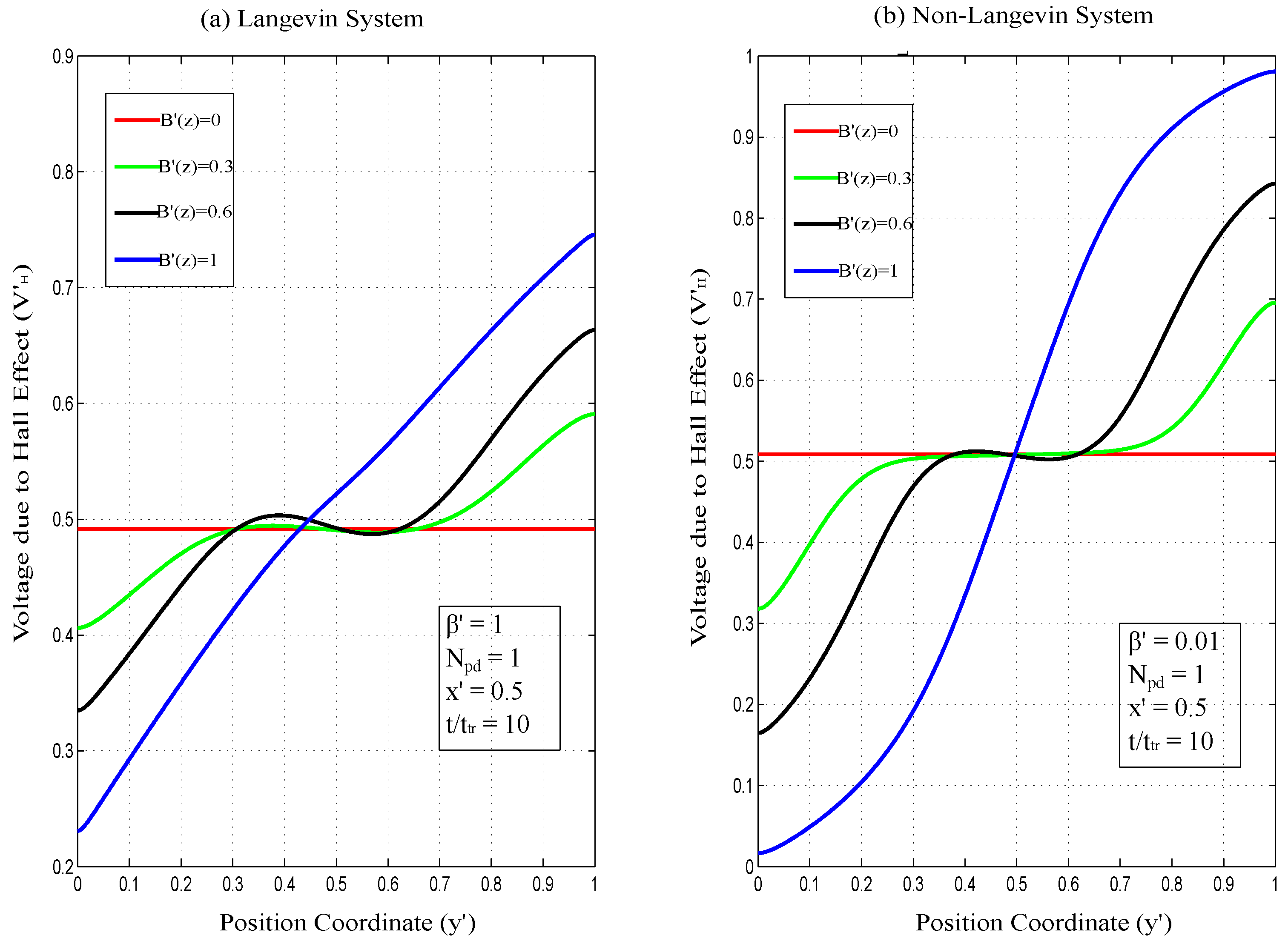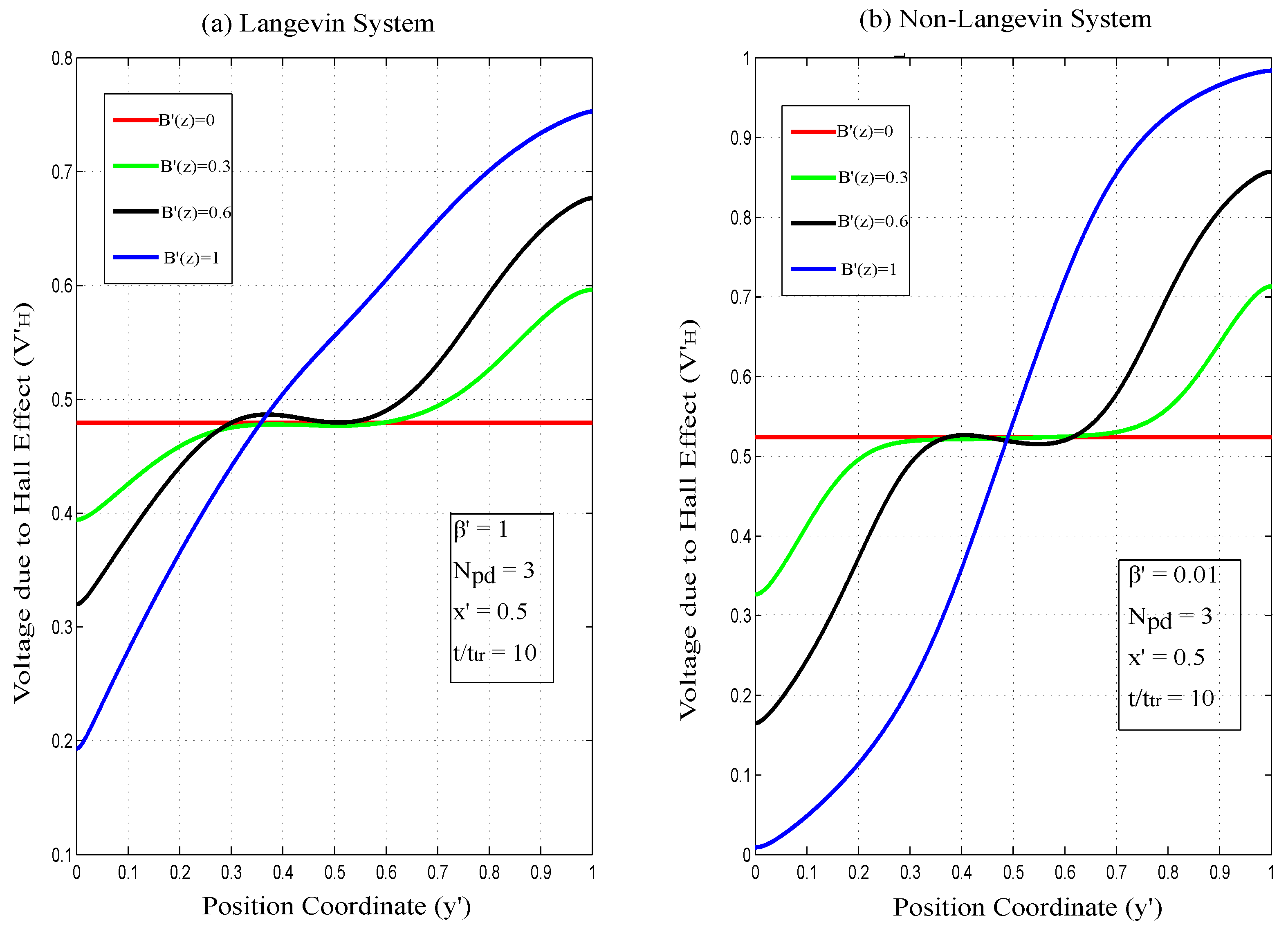Charge Transport Characteristics in Doped Organic Semiconductors Using Hall Effect
Abstract
1. Introduction
2. Methodology
2.1. Device Modelling Using Numerical Methods
2.2. Simulation Settings
3. Results and Discussion
3.1. Impact of n-Type Doping on Number Density of Carriers
3.2. Effect of n-Type Doping on the Hall Voltage
4. Conclusions
Author Contributions
Funding
Data Availability Statement
Acknowledgments
Conflicts of Interest
References
- Nishide, J.I.; Nakanotani, H.; Hiraga, Y.; Adachi, C. High-efficiency white organic light-emitting diodes using thermally activated delayed fluorescence. Appl. Phys. Lett. 2014, 104, 233304. [Google Scholar] [CrossRef]
- Nakanotani, H.; Higuchi, T.; Furukawa, T.; Masui, K.; Morimoto, K.; Numata, M.; Tanaka, H.; Sagara, Y.; Yasuda, T.; Adachi, C. High-efficiency organic light-emitting diodes with fluorescent emitters. Nat. Commun. 2014, 5, 4016. [Google Scholar] [CrossRef]
- Jou, J.H.; Kumar, S.; Agrawal, A.; Li, T.H.; Sahoo, S. Approaches for fabricating high efficiency organic light emitting diodes. J. Mater. Chem. C 2015, 3, 2974–3002. [Google Scholar] [CrossRef]
- Miwa, T.; Kubo, S.; Shizu, K.; Komino, T.; Adachi, C.; Kaji, H. Blue organic light-emitting diodes realizing external quantum efficiency over 25% using thermally activated delayed fluorescence emitters. Sci. Rep. 2017, 7, 1–8. [Google Scholar] [CrossRef] [PubMed]
- Lu, L.; Zheng, T.; Wu, Q.; Schneider, A.M.; Zhao, D.; Yu, L. Recent advances in bulk heterojunction polymer solar cells. Chem. Rev. 2015, 115, 12666–12731. [Google Scholar] [CrossRef]
- Yuan, J.; Gu, J.; Shi, G.; Sun, J.; Wang, H.Q.; Ma, W. High efficiency all-polymer tandem solar cells. Sci. Rep. 2016, 6, 26459. [Google Scholar] [CrossRef]
- Liu, J.; Chen, S.; Qian, D.; Gautam, B.; Yang, G.; Zhao, J.; Bergqvist, J.; Zhang, F.; Ma, W.; Ade, H.; et al. Fast charge separation in a non-fullerene organic solar cell with a small driving force. Nat. Energy 2016, 1, 16089. [Google Scholar] [CrossRef]
- Youn, H.; Park, H.J.; Guo, L.J. Organic photovoltaic cells: From performance improvement to manufacturing processes. Small 2015, 11, 2228–2246. [Google Scholar] [CrossRef] [PubMed]
- Fei, Z.; Pattanasattayavong, P.; Han, Y.; Schroeder, B.C.; Yan, F.; Kline, R.J.; Anthopoulos, T.D.; Heeney, M. Influence of side-chain regiochemistry on the transistor performance of high-mobility, all-donor polymers. J. Am. Chem. Soc. 2014, 136, 15154–15157. [Google Scholar] [CrossRef]
- Bronstein, H.; Leem, D.S.; Hamilton, R.; Woebkenberg, P.; King, S.; Zhang, W.; Ashraf, R.S.; Heeney, M.; Anthopoulos, T.D.; Mello, J.d.; et al. Indacenodithiophene-co-benzothiadiazole copolymers for high performance solar cells or transistors via alkyl chain optimization. Macromolecules 2011, 44, 6649–6652. [Google Scholar] [CrossRef]
- Zhang, X.; Bronstein, H.; Kronemeijer, A.J.; Smith, J.; Kim, Y.; Kline, R.J.; Richter, L.J.; Anthopoulos, T.D.; Sirringhaus, H.; Song, K.; et al. Molecular origin of high field-effect mobility in an indacenodithiophene–benzothiadiazole copolymer. Nat. Commun. 2013, 4, 2238. [Google Scholar] [CrossRef]
- Yan, H.; Chen, Z.; Zheng, Y.; Newman, C.; Quinn, J.R.; Dötz, F.; Kastler, M.; Facchetti, A. A high-mobility electron-transporting polymer for printed transistors. Nature 2009, 457, 679–686. [Google Scholar] [CrossRef] [PubMed]
- Paterson, A.F.; Singh, S.; Fallon, K.J.; Hodsden, T.; Han, Y.; Schroeder, B.C.; Bronstein, H.; Heeney, M.; McCulloch, I.; Anthopoulos, T.D. Recent progress in high-mobility organic transistors: A reality check. Adv. Mater. 2018, 30, 1801079. [Google Scholar] [CrossRef] [PubMed]
- Uemura, T.; Rolin, C.; Ke, T.H.; Fesenko, P.; Genoe, J.; Heremans, P.; Takeya, J. On the Extraction of Charge Carrier Mobility in High-Mobility Organic Transistors. Adv. Mater. 2016, 28, 151–155. [Google Scholar] [CrossRef]
- Mandal, S.; Noh, Y.Y. Printed organic thin-film transistor-based integrated circuits. Semicond. Sci. Technol. 2015, 30, 064003. [Google Scholar] [CrossRef]
- Lee, T.; Chen, Y. Organic resistive nonvolatile memory materials. MRS Bull. 2012, 37, 144–149. [Google Scholar] [CrossRef]
- Yamamoto, Y.; Yoshino, K.; Inuishi, Y. Electrical properties of phthalocyanine-halogen complexes. J. Phys. Soc. Jpn. 1979, 47, 1887–1891. [Google Scholar] [CrossRef]
- Chiang, C.K.; Fincher, C., Jr.; Park, Y.W.; Heeger, A.J.; Shirakawa, H.; Louis, E.J.; Gau, S.C.; MacDiarmid, A.G. Electrical conductivity in doped polyacetylene. Phys. Rev. Lett. 1977, 39, 1098. [Google Scholar] [CrossRef]
- McNeill, R.; Siudak, R.; Wardlaw, J.; Weiss, D. Electronic conduction in polymers. I. The chemical structure of polypyrrole. Aust. J. Chem. 1963, 16, 1056–1075. [Google Scholar] [CrossRef]
- De Surville, R.; Jozefowicz, M.; Yu, L.; Pepichon, J.; Buvet, R. Electrochemical chains using protolytic organic semiconductors. Electrochim. Acta 1968, 13, 1451–1458. [Google Scholar] [CrossRef]
- McGinness, J.; Corry, P.; Proctor, P. Amorphous semiconductor switching in melanins. Science 1974, 183, 853–855. [Google Scholar] [CrossRef] [PubMed]
- Parthasarathy, G.; Shen, C.; Kahn, A.; Forrest, S. Lithium doping of semiconducting organic charge transport materials. J. Appl. Phys. 2001, 89, 4986–4992. [Google Scholar] [CrossRef]
- Kido, J.; Matsumoto, T. Bright organic electroluminescent devices having a metal-doped electron-injecting layer. Appl. Phys. Lett 1998, 73, 2866. [Google Scholar] [CrossRef]
- Endo, J.; Matsumoto, T.; Kido, J. Organic electroluminescent devices with a vacuum-deposited Lewis-acid-doped hole-injecting layer. Jpn. J. Appl. Phys. 2002, 41, L358. [Google Scholar] [CrossRef]
- Kearns, D.R.; Tollin, G.; Calvin, M. Electrical properties of organic solids. II. effects of added electron acceptor on metal-free phthalocyanine. J. Chem. Phys. 1960, 32, 1020–1025. [Google Scholar] [CrossRef]
- Maitrot, M.; Guillaud, G.; Boudjema, B.; André, J.; Simon, J. Molecular material-based junctions: Formation of a Schottky contact with metallophthalocyanine thin films doped by the cosublimation method. J. Appl. Phys. 1986, 60, 2396–2400. [Google Scholar] [CrossRef]
- Andre, J.; Simon, J.; Even, R.; Boudjema, B.; Guillaud, G.; Maitrot, M. Molecular semiconductors and junction formation: Phthalocyanine derivatives. Synth. Met. 1987, 18, 683–688. [Google Scholar] [CrossRef]
- Marks, T.J. Electrically conductive metallomacrocyclic assemblies. Science 1985, 227, 881–889. [Google Scholar] [CrossRef]
- Lous, E.; Blom, P.; Molenkamp, L.; De Leeuw, D. Schottky contacts on a highly doped organic semiconductor. Phys. Rev. B 1995, 51, 17251. [Google Scholar] [CrossRef]
- Maennig, B.; Pfeiffer, M.; Nollau, A.; Zhou, X.; Leo, K.; Simon, P. Controlled p-type doping of polycrystalline and amorphous organic layers: Self-consistent description of conductivity and field-effect mobility by a microscopic percolation model. Phys. Rev. B 2001, 64, 195208. [Google Scholar] [CrossRef]
- Harada, K.; Werner, A.; Pfeiffer, M.; Bloom, C.; Elliott, C.; Leo, K. Organic homojunction diodes with a high built-in potential: Interpretation of the current-voltage characteristics by a generalized Einstein relation. Phys. Rev. Lett. 2005, 94, 036601. [Google Scholar] [CrossRef] [PubMed]
- Olthof, S.; Tress, W.; Meerheim, R.; Lüssem, B.; Leo, K. Photoelectron spectroscopy study of systematically varied doping concentrations in an organic semiconductor layer using a molecular p-dopant. J. Appl. Phys. 2009, 106, 103711. [Google Scholar] [CrossRef]
- Huang, Q.; Walzer, K.; Pfeiffer, M.; Lyssenko, V.; He, G.; Leo, K. Highly efficient top emitting organic light-emitting diodes with organic outcoupling enhancement layers. Appl. Phys. Lett. 2006, 88, 113515. [Google Scholar] [CrossRef]
- Meerheim, R.; Walzer, K.; Pfeiffer, M.; Leo, K. Ultrastable and efficient red organic light emitting diodes with doped transport layers. Appl. Phys. Lett. 2006, 89, 061111. [Google Scholar] [CrossRef]
- Reineke, S.; Lindner, F.; Schwartz, G.; Seidler, N.; Walzer, K.; Lüssem, B.; Leo, K. White organic light-emitting diodes with fluorescent tube efficiency. Nature 2009, 459, 234–238. [Google Scholar] [CrossRef]
- Schulze, K.; Uhrich, C.; Schüppel, R.; Leo, K.; Pfeiffer, M.; Brier, E.; Reinold, E.; Bäuerle, P. Efficient vacuum-deposited organic solar cells based on a new low-bandgap oligothiophene and fullerene C60. Adv. Mater. 2006, 18, 2872–2875. [Google Scholar] [CrossRef]
- Uhrich, C.; Wynands, D.; Olthof, S.; Riede, M.K.; Leo, K.; Sonntag, S.; Maennig, B.; Pfeiffer, M. Origin of open circuit voltage in planar and bulk heterojunction organic thin-film photovoltaics depending on doped transport layers. J. Appl. Phys. 2008, 104, 043107. [Google Scholar] [CrossRef]
- Wynands, D.; Levichkova, M.; Leo, K.; Uhrich, C.; Schwartz, G.; Hildebrandt, D.; Pfeiffer, M.; Riede, M. Increase in internal quantum efficiency in small molecular oligothiophene: C 60 mixed heterojunction solar cells by substrate heating. Appl. Phys. Lett. 2010, 97, 073503. [Google Scholar] [CrossRef]
- Fallahpour, A.; Gagliardi, A.; Gentilini, D.; Zampetti, A.; Santoni, F.; Auf der Maur, M.; Di Carlo, A. Optoelectronic simulation and thickness optimization of energetically disordered organic solar cells. J. Comput. Electron. 2014, 13, 933–942. [Google Scholar] [CrossRef]
- Gagliardi, A.; der Maur, M.A.; Gentilini, D.; di Fonzo, F.; Abrusci, A.; Snaith, H.J.; Divitini, G.; Ducati, C.; Di Carlo, A. The real TiO 2/HTM interface of solid-state dye solar cells: Role of trapped states from a multiscale modelling perspective. Nanoscale 2015, 7, 1136–1144. [Google Scholar] [CrossRef]
- Fallahpour, A.H.; Gentilini, D.; Gagliardi, A.; der Maur, M.A.; Lugli, P.; Di Carlo, A. Systematic study of the PCE and device operation of organic tandem solar cells. IEEE J. Photovoltaics 2015, 6, 202–210. [Google Scholar] [CrossRef]
- Darwish, M.; Boysan, H.; Liewald, C.; Nickel, B.; Gagliardi, A. A resistor network simulation model for laser-scanning photo-current microscopy to quantify low conductance regions in organic thin films. Org. Electron. 2018, 62, 474–480. [Google Scholar] [CrossRef]
- Gagliardi, A.; Wang, S.; Albes, T. Simulation of charge Carrier mobility unbalance in organic solar cells. Org. Electron. 2018, 59, 171–176. [Google Scholar] [CrossRef]
- Zubair, M.; Ang, Y.S.; Ang, L.K. Thickness dependence of space-charge-limited current in spatially disordered organic semiconductors. IEEE Trans. Electron Devices 2018, 65, 3421–3429. [Google Scholar] [CrossRef]
- Pivrikas, A.; Neugebauer, H.; Sariciftci, N.S. Charge carrier lifetime and recombination in bulk heterojunction solar cells. IEEE J. Sel. Top. Quantum Electron. 2010, 16, 1746–1758. [Google Scholar] [CrossRef]
- Pivrikas, A.; Ullah, M.; Simbrunner, C.; Sitter, H.; Neugebauer, H.; Sariciftci, N.S. Comparative study of bulk and interface transport in disordered fullerene films. Phys. Status Solidi (B) 2011, 248, 2656–2659. [Google Scholar] [CrossRef]
- Funahashi, M. Time-of-Flight Method for Determining the Drift Mobility in Organic Semiconductors. In Organic Semiconductors for Optoelectronics; Wiley: Hoboken, NJ, USA, 2021; pp. 161–178. [Google Scholar]
- Yi, H.; Gartstein, Y.N.; Podzorov, V. Charge carrier coherence and Hall effect in organic semiconductors. Sci. Rep. 2016, 6, 23650. [Google Scholar] [CrossRef] [PubMed]
- Choi, H.H.; Paterson, A.F.; Fusella, M.A.; Panidi, J.; Solomeshch, O.; Tessler, N.; Heeney, M.; Cho, K.; Anthopoulos, T.D.; Rand, B.P.; et al. Hall effect in polycrystalline organic semiconductors: The effect of grain boundaries. Adv. Funct. Mater. 2020, 30, 1903617. [Google Scholar] [CrossRef]
- Neukom, M.; Reinke, N.; Ruhstaller, B. Charge extraction with linearly increasing voltage: A numerical model for parameter extraction. Solar Energy 2011, 85, 1250–1256. [Google Scholar] [CrossRef]
- Koster, L.J.; Smits, E.; Mihailetchi, V.; Blom, P.W. Device model for the operation of polymer/fullerene bulk heterojunction solar cells. Phys. Rev. B 2005, 72, 085205. [Google Scholar] [CrossRef]
- Hwang, I.; McNeill, C.R.; Greenham, N.C. Drift-diffusion modeling of photocurrent transients in bulk heterojunction solar cells. J. Appl. Phys. 2009, 106, 094506. [Google Scholar] [CrossRef]
- Neukom, M.T.; Züfle, S.; Ruhstaller, B. Reliable extraction of organic solar cell parameters by combining steady-state and transient techniques. Org. Electron. 2012, 13, 2910–2916. [Google Scholar] [CrossRef]
- MacKenzie, R.C.; Shuttle, C.G.; Chabinyc, M.L.; Nelson, J. Extracting microscopic device parameters from transient photocurrent measurements of P3HT: PCBM solar cells. Adv. Energy Mater. 2012, 2, 662–669. [Google Scholar] [CrossRef]
- Hanfland, R.; Fischer, M.A.; Brütting, W.; Würfel, U.; MacKenzie, R.C. The physical meaning of charge extraction by linearly increasing voltage transients from organic solar cells. Appl. Phys. Lett. 2013, 103, 063904. [Google Scholar] [CrossRef]
- Hwang, I.; Greenham, N.C. Modeling photocurrent transients in organic solar cells. Nanotechnology 2008, 19, 424012. [Google Scholar] [CrossRef]
- Rogel-Salazar, J.; Bradley, D.D.; Cash, J.; Demello, J. An efficient method-of-lines simulation procedure for organic semiconductor devices. Phys. Chem. Chem. Phys. 2009, 11, 1636–1646. [Google Scholar] [CrossRef]
- Juška, G.; Viliunas, M.; Klíma, O.; Šípek, E.; Kočka, J. New features in space-charge-limited-photocurrent transients. Philos. Mag. B 1994, 69, 277–289. [Google Scholar] [CrossRef]
- Juška, G.; Viliunas, M.; Arlauskas, K.; Kočka, J. Space-charge-limited photocurrent transients: The influence of bimolecular recombination. Phys. Rev. B 1995, 51, 16668. [Google Scholar] [CrossRef]
- Pivrikas, A.; Juška, G.; Mozer, A.J.; Scharber, M.; Arlauskas, K.; Sariciftci, N.; Stubb, H.; Österbacka, R. Bimolecular recombination coefficient as a sensitive testing parameter for low-mobility solar-cell materials. Phys. Rev. Lett. 2005, 94, 176806. [Google Scholar] [CrossRef]
- Pivrikas, A.; Sariciftci, N.S.; Juška, G.; Österbacka, R. A review of charge transport and recombination in polymer/fullerene organic solar cells. Prog. Photovoltaics Res. Appl. 2007, 15, 677–696. [Google Scholar] [CrossRef]
- Blochwitz, J.; Fritz, T.; Pfeiffer, M.; Leo, K.; Alloway, D.M.; Lee, P.A.; Armstrong, N.R. Interface electronic structure of organic semiconductors with controlled doping levels. Org. Electron. 2001, 2, 97. [Google Scholar] [CrossRef]
- Werner, A.; Li, F.; Harada, K.; Pfeiffer, M.; Fritz, T.; Leo, K.; Machill, S. n-Type doping of organic thin films using cationic dyes. Adv. Funct. Mater. 2004, 14, 255–260. [Google Scholar] [CrossRef]
- Li, F.; Werner, A.; Pfeiffer, M.; Leo, K.; Liu, X. Leuco crystal violet as a dopant for n-doping of organic thin films of fullerene C60. J. Phys. Chem. B 2004, 108, 17076–17082. [Google Scholar] [CrossRef]
- Ellmer, K. Hall effect and conductivity measurements in semiconductor crystals and thin films. In Characterization of Materials; Wiley: Hoboken, NJ, USA, 2012; pp. 1–16. [Google Scholar]







| Magnetic Field | Langevin | Non-Langevin | Langevin | Non-Langevin | Steady State |
|---|---|---|---|---|---|
| 0 | 0 | 0 | 0 | 0 | 0 |
| 0.3 | 0.19 | 0.38 | 0.2 | 0.39 | 0.3 |
| 0.6 | 0.33 | 0.68 | 0.35 | 0.69 | 0.6 |
| 1 | 0.51 | 0.97 | 0.56 | 0.971 | 1 |
Disclaimer/Publisher’s Note: The statements, opinions and data contained in all publications are solely those of the individual author(s) and contributor(s) and not of MDPI and/or the editor(s). MDPI and/or the editor(s) disclaim responsibility for any injury to people or property resulting from any ideas, methods, instructions or products referred to in the content. |
© 2024 by the authors. Licensee MDPI, Basel, Switzerland. This article is an open access article distributed under the terms and conditions of the Creative Commons Attribution (CC BY) license (https://creativecommons.org/licenses/by/4.0/).
Share and Cite
Morab, S.; Sundaram, M.M.; Pivrikas, A. Charge Transport Characteristics in Doped Organic Semiconductors Using Hall Effect. Electronics 2024, 13, 4223. https://doi.org/10.3390/electronics13214223
Morab S, Sundaram MM, Pivrikas A. Charge Transport Characteristics in Doped Organic Semiconductors Using Hall Effect. Electronics. 2024; 13(21):4223. https://doi.org/10.3390/electronics13214223
Chicago/Turabian StyleMorab, Seema, Manickam Minakshi Sundaram, and Almantas Pivrikas. 2024. "Charge Transport Characteristics in Doped Organic Semiconductors Using Hall Effect" Electronics 13, no. 21: 4223. https://doi.org/10.3390/electronics13214223
APA StyleMorab, S., Sundaram, M. M., & Pivrikas, A. (2024). Charge Transport Characteristics in Doped Organic Semiconductors Using Hall Effect. Electronics, 13(21), 4223. https://doi.org/10.3390/electronics13214223






